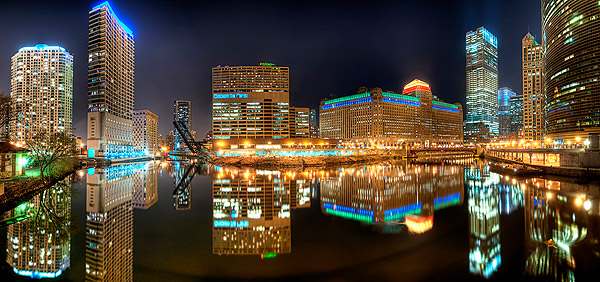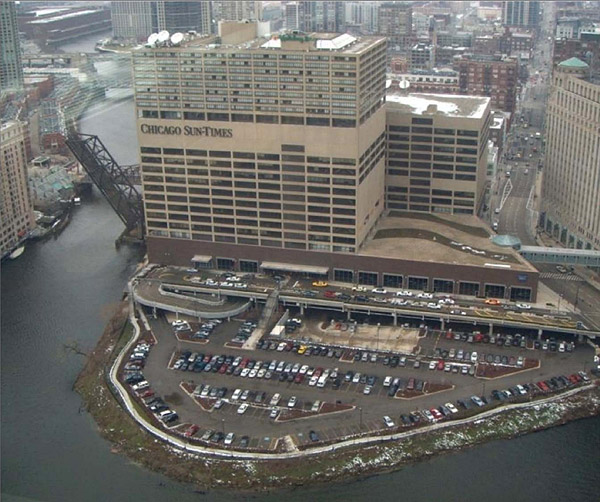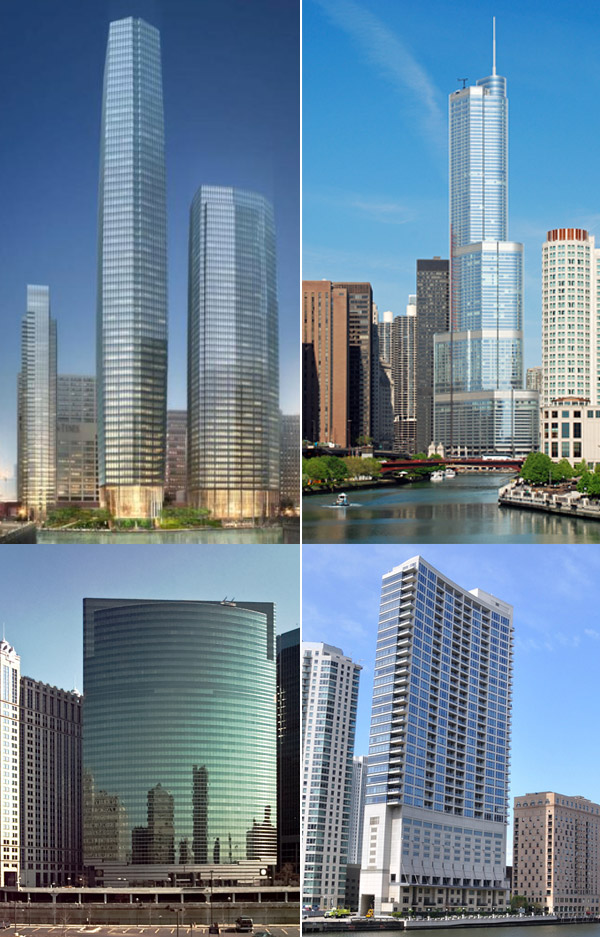For the time being, development controversy has shifted from Prentice Hospital to Wolf Point, at the confluence of the Chicago River's branches. It's a bit like New York's Governor's Island in miniature—a spectacular waterfront location that's remained in low-usage limbo for decades, doing the city no favors from an aesthetic or economic standpoint. Here's what it looks like from the Lake Street bridge (via):

But that view masks the reality of Wolf Point, which is that it's a parking lot in the shadow of the abysmally designed Apparel Center (PDF).

Wolf Point isn't just of historical significance; it's also surrounded by generally pretty successful architecture: the muscular Merchandise Mart, the river-mirroring 333 West Wacker (where I used to work; the views are spectacular), the less dramatically river-mirroring Residences at Riverbend, and 300 North LaSalle, with its riverfront garden. There's a lot riding on it, and it comes just as the city is set to set to make a new announcement about the riverwalk (more on that in a forthcoming column), which will terminate across the river from Wolf Point. Which is why no one's happy.
* First, Lynn Becker takes a long look at Wolf Point—its history, its recent controversy, its future. Becker is okay with the first tower, but is mildly underwhelmed with its future plans. His take on the riverwalk is particularly interesting; Becker suggests treating it more like the lakefront than what currently exists of the city's riverwalk:
The standard river promenade, that "alpha" point of visual, visceral urban excitement? By all means. But to use it to erase the last remnant of the natural state from which Chicago arose is not so much an enhancement, as an impoverishing. Is the soft, natural edge of today's Wolf Point a direct link to Miller's Tavern? No, it's a re-creation. But even so, it's a necessary antidote to the mistaken, if pervasive misconception that a great city arises out of order alone. Improvisation is the creative spark that fuels the growth of cities, and it should be allowed to endure at Wolf Point, in a generous outlying bib to the formal promenade, where nature, lightly guided, may continue to take its course, and people can make their own paths
* The Chicago Architecture Blog, meanwhile, focuses on the chaos at the intersection of politics and planning, and the concern that the designs of bKL and Pelli Clarke Pelli are too comfortable (reflecting Becker's reaction):
The last speaker of the afternoon was internet architecture booster Butler Adams, who made a great point that was lost in all the rancor surrounding the development: It’s boring.
[snip]
It was a delightful moment of schadenfreude to see him [Fred Clarke of Pelli Clarke Pelli] have to sit there and listen to some punk from the internet call him out for recycling the design of a building in South America for use in Chicago, as if no one would notice. (We’re not sure exactly which building Mr. Adams was referring to, but it could be any of the raft of similar-looking PCP towers like the Gran Torre Santiago in Chile, Torre Cajasol in Seville, the Jingui Li Iconic Tower in China, or even the Landmark in Abu Dhabi.)
IMO: I can see it with the Landmark and Jingui Li, both glassy, light, sail-shaped buildings resembling the as-yet-unapproved PCP designs. Not so much the Gran Torre Santiago or Torre Cajasol. If they're going to imitate themselves, we should see about the Jingui Li galleria.
But even if you buy that PCP's designs are too close to ones they've built elsewhere, that's not to say that they don't fit in with the skyline. If the whole shebang is built as it's currently planned, one way to imagine it is this: the first tower, from bKL, is a better version of Residences at Riverbend; the two PCP buildings look like more sculptural versions of the Trump Tower, which everyone seems to generally like, and a bit of 333 West Wacker.

Clockwise from upper left: the proposed Wolf Point towers; Trump Tower; Residences at Riverbend; 333 West Wacker / via Wikimedia Commons, Wolf Point Development, and vxla
So the towers would communicate with their surroundings; part of the beef, I take it, is maybe they do so a bit too much.
* And finally, Steven Vance at Streetsblog Chicago, on the development's problematically large demand for parking, which is below that of comparable buildings, but nonetheless substantial. The parking will be underground, which is good, but Vance focuses on its effect on the streets around Wolf Point.
As part of this first phase, the developers will pay for a wish list of transportation-related changes requested by CDOT, but the changes to local streets are intended mainly to accommodate a projected increase in car traffic, not make walking, biking, or transit a more attractive option for getting to Wolf Point.
Anyhow, here are the current ideas for how it will look. One thing I think all architecture-minded Chicagoans can agree on: it does a fine job hiding the Apparel Mart.


